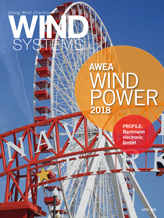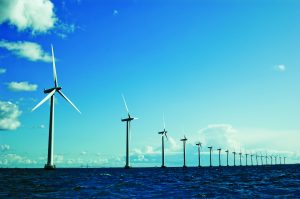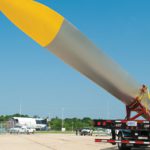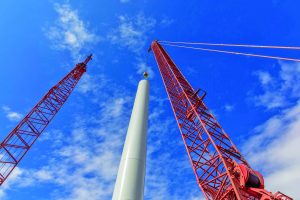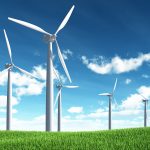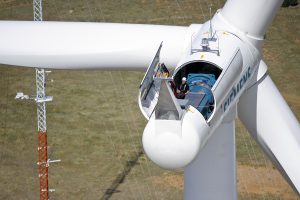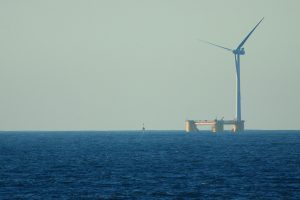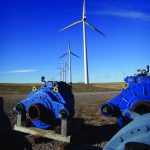The operational challenges for wind turbines can be daunting, whether related to increased turbine power and size, extreme weather conditions, heavy loads, and/or remote locations, among many others. In turn, significant advances in rolling bearing designs, materials, and engineering have helped to realize enhanced performance, reliability, and service life at all points in wind turbines.
Some of the recent innovations in bearing technologies serve to illustrate how far bearing technologies have evolved in meeting operational demands and improving the productivity and profitability of wind turbines, whether on land or offshore.
High endurance slewing bearings
Slewing bearings historically have equipped a wide range of applications across industries, including wind turbines. These bearings consist of an inner ring and an outer ring, one of which usually incorporates a gear. Together with attachment holes in both rings, they enable optimized power transmission with a simple and quick connection between adjacent machine components. The bearing raceways, in conjunction with the rolling elements and cages or spacers, accommodate loads acting singly or in combination and in any direction.
Among typical turbine applications, slewing bearings will be used as pitch bearings to optimize blade position for different wind conditions or as yaw bearings to correctly position the nacelle during operation. A new generation of high endurance slewing bearings raises the bar for performance and reliability in service.

This class of bearings benefits from enhanced internal bearing geometry in the cages and raceways to reduce friction and increase turbine and pitch control performance. Reduced friction contributes to pitch system effectiveness and efficiency to maximize energy production.
As an added plus, a unique seal material, manufactured from polyurethane, provides better resistance to ozone, UV light, and salt water compared with conventional nitrile-based seals, thereby reducing wear and providing relatively longer service life. The seal design itself has been engineered to be less sensitive to ring deformation during operation for ideal seal function under high loads and reduced grease leakage and water ingress, which results in improved robustness and lower maintenance costs down the road.
Self-aligning bearing system
In typical industrial applications, a bearing system must accommodate misalignment, shaft deflections, and thermal expansion of shafts. To cope with misalignment and shaft deflections, design engineers conventionally use a bearing arrangement consisting of two self-aligning ball bearings or two spherical roller bearings. However, thermal expansion of a shaft is a more complex issue requiring one of the bearings to be a “locating” bearing and the other to be a “non-locating” bearing.
In most cases, the locating bearing must be secured in the housing and on the shaft. The non-locating bearing, in contrast, has to be able to move axially on its seat in the housing. To achieve this movement, the bearing’s outer ring must be mounted with a loose fit and have enough room to move in the axial direction. The loose fit, however, under certain load conditions, can allow the bearing ring to creep and damage the housing seat. This accelerates wear, increases vibration, and provides less rigid shaft support in the radial direction.
In addition, when the non-locating bearing moves in the housing, the movement generates a considerable amount of friction, which then further induces vibration, axial forces in the bearing system, and heat — all threatening to reduce bearing service life.
An effective alternative to this conventional and problematic “locating/non-locating” bearing arrangement ideally suited for wind turbines is a system combining a self-aligning spherical roller bearing in the locating position and a CARB (compact aligning roller bearing) toroidal roller bearing in the non-locating position.
The CARB toroidal roller bearing is a self-aligning radial bearing able to accommodate both misalignment and axial displacement of the shaft inside the bearing at the same time. This helps to eliminate the risk of induced axial loads, improve reliability, and enable the cross-section of the bearing to be smaller than possible with standard types.
CARB bearings exhibit very high load-carrying capacity, high running accuracy, low friction, and resistance to wear resulting in reduced noise and vibration and promoting improved reliability and longer service life. They integrate design features from several conventional bearing types. They can accommodate misalignment (similar to a spherical roller bearing), adjust for axial expansion of a shaft (similar to a cylindrical roller bearing), and maximize load capacity due to long self-guiding rollers (similar to needle roller bearings).
A self-aligning bearing system combining spherical roller and CARB toroidal roller bearings can further contribute to a lighter, more compact wind turbine compared with conventional arrangements. Owners and operators can benefit from reduced tower and foundation weight and improved reliability, which can translate into reduced maintenance and operating costs.
Main shaft bearings in drive trains
Wind-turbine drive trains use one of three concepts: turbines with gearboxes, hybrid turbines, and gearless turbines (direct drive). Whereas turbines with gearboxes were once standard, the trend is toward direct drive turbines with permanent magnet technology, which are relatively lighter and more compact.
The portfolio of main shaft bearing solutions has been significantly expanded with the recent introduction of spherical roller bearings designed explicitly for wind-turbine main shafts. The heavy-duty bearings can significantly improve reliability and bearing life, in turn reducing the levelized cost of energy (LCOE).

Noteworthy features compared with standard spherical roller bearings include modified inner geometry with super-finished functional surfaces, optimized contact pressures, robust cast-iron cages, and significant total weight reduction. The resulting benefits: improved performance and enhanced reliability under typical wind-operating conditions and overall best-in-class ranking. Bearing boundary dimensions, in compliance with ISO standards, are compatible with existing arrangements, allowing for swap-out and upgrades.
These new bearings join a family of advanced stiff bearings (the Nautilus series in the case of SKF) providing high carrying capacity with minimum friction on turbine drive trains.
Designed to handle heavy and complex loads, this is a single bearing solution based on double row tapered roller bearings, arranged back-to-back. These two rows lock the unit axially and deliver extremely high stiffness. The compact bearing design helps reduce nacelle dimensions and weight and helps reduce production costs, in part, because tower and fundamental weight can be decreased.
The bearings, which can integrate a variety of options or otherwise be customized, have been designed overall to improve ease of installation, increase reliability and operational safety, enhance maintainability and reduce operating and maintenance cost, and increase turbine productivity, availability, and profitability.
Recent improvements include an enhanced segmented cage, a bolted inner ring, sealed and pre-greased units, and corrosion protection:
- The segmented cage technology consists of a single-pocket cage, which can operate in a flexible environment with the bearing being preloaded — a prerequisite for a stiff surrounding structure resulting in a stiff drive train. This new design makes it possible to increase the static and dynamic load-carrying capacity of the bearing, and the segmentation improves the roller guiding to deliver optimized load distribution among the rollers. The window-type cage further provides extremely low friction and makes the bearing less sensitive to inadequate lubrication conditions, resulting in less wear.
- A bolted inner ring allows the bearing to be attached directly to the rotor hub and mainframe, thus reducing bearing preload variations and resulting in higher operational reliability and safety, easier mounting, replacement and maintainability.
- Units can be supplied already sealed and pregreased with optimized grease fill, virtually eliminating any chance of contamination during manufacture and installation.
- Corrosion protection can be achieved with the application of a specialized corrosion-inhibiting coating, especially appealing for turbines in harsh offshore environments.
Black oxide bearings
Wind-turbine bearings must endure widely varying temperatures, speeds, and loads, plus exposure to contaminants, including moisture and chemicals. These conditions can limit bearing service life and increase already high operation and maintenance expenses. An innovative black oxide surface treatment offers a viable line of defense for a variety of wind-turbine bearings.
The black oxide coating can be specified for all types of critical bearings in wind-turbine systems to help promote higher reliability against widely varying temperatures, speeds, and loads and to resist moisture and chemicals that otherwise could limit bearing lifecycles and increase costs of turbine operation and maintenance.
This surface treatment is applied to a bearing’s rings and/or rollers. The process — involving a chemical reaction at the surface layer of the bearing steel — is performed in an alkaline aqueous salt solution at defined temperatures. Up to 15 different immersion steps create a thin, dark black surface layer delivering a significant performance upgrade for the broad range of bearing types and sizes in wind turbines (up to 2.2 meters in diameter and up to 1,000 kilograms per individual bearing component).
Black oxide bearings can increase turbine uptime by enhancing resistance to corrosion and smearing; improving performance in low-lubrication conditions; limiting risk of fretting, micropitting, and cracking; reducing potential damage from aggressive oil additives; and reducing the effects of friction and wear.
Suitable bearing types for the coating include tapered roller bearings, cylindrical roller bearings, spherical roller bearings, and CARB toroidal roller bearings, among others playing vital roles in wind-turbine systems.
Black oxide coated bearings can be specified for new installations or as replacements for conventional bearings of many types without encroaching on existing design envelopes.
All these examples of bearing innovations for wind-turbine applications individually and collectively can help support sustainable and ongoing success for wind-farm operations.
More innovations can be expected on the horizon as technology responds to the ever-present and emerging demands on the wind farm.
















